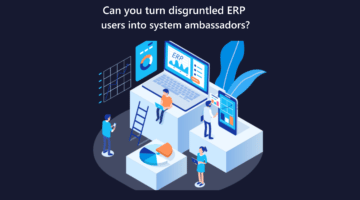How to manage expectations before implementing an ERP system

For most businesses, the decision to implement an ERP system often follows a long thought-out process. There are many reasons why management believes it’s a good strategic move. In some cases it amounts to better traceability. But the trade-off is typically additional contact points for recording data. Now you have a disgruntled team. Fortunately with planning and foresight you can turn disgruntled users into early adopters and even system ambassadors. See below how it’s done.
Why ERP system in the first place?
The ultimate purpose of implementing an ERP system is to level up productivity and reduce costs. It is purpose-built to integrate workflows and processes across an organisation. And it usually replaces multiple functionally separate systems that are siloed into internal units such as; manufacturing, finance and CRM.
From an organisational perspective the deployment of a single solution instead of multiple separate ones creates greater transparency and provides much valued insights. Unfortunately it also introduces more friction such as additional contact points.
Before deploying an ERP system it’s important to ensure end users understand why all of a sudden a bundle of new contact points are necessary. Simply expecting them to embrace a whole set of extra process steps they traditionally didn’t use could lead to mounting misunderstandings and frustration.
If the overall benefits of implementing an ERP system are not communicated effectively it could lead the project down a slippery slope to a blowout.
The ability to manage change can make or break implementations
A transition from a multi-system environment to a unified one often forces organisations to re-think their processes. The change often calls on users to adjust to a new reality.
To enhance the user experience and reduce angst, users need training about the new system and processes. They need to understand the benefits of making the transition to a unified platform.
Just how well an organisation manages change can make or break an implementation.
Let’s look at two new implementation use cases and how they affect day-to-day work processes.
Use case 1
In one scenario the user receives an order in an ERP system directly from the customer via an EDI. The order is triggered by a purchase order created in the customer’s system
An ERP such as Microsoft Dynamics 365 receives all the order’s relevant details without any effort on behalf of the user. In this case placing the order manually, a time-consuming process, is no longer needed. Here we can move directly to produce and dispatch the order to the customers’ requirements.
The benefits of such a process are often clearly visible. Better still, it needs minimal change management to get everyone on board.
Use case 1
Another use case focuses on an order that is processed in the system but mistakenly, it never arrives. In this case the order needs to be reversed. In a disconnected financial environment you would simply delete or reverse the order with little more than a short reason. But in an ERP environment the items are received in the inventory and an invoice is generated. This creates a financial footprint in the database.
Now simply deleting the order is not possible. The user will need to process another transaction to credit the financial data and reverse the inventory out of the system.
Whilst from an organisational perspective this kind of transparency is beneficial, it often requires extra steps that were previously streamlined.
Identifying potential objections and addressing them is key
It’s important early on in the implementation to identify where the user’s everyday processes are going to be more fluid and when they’ll need extra steps to transact effectively.
Users need to be onboard when processes involve extra steps. They need to see the bigger picture. And they need to understand the greater good of a more transparent and productive system.
Improper hands-on training can spell out the difference between a successful implementation and onboarding, and a compromised one. If users are not on-board, the implementation can go pear-shape despite careful setup planning.
Field-proven ways to prepare a team for ERP implementation
- From an early project stage the organisation needs to build a case story why it needs the implementation. It needs to address the whole organisation, especially the foreseen heavy ERP users.
- Communicating early on about the implementation lets users prepare for the transition. It’s no secret that workers do not like change. Informing them early on conditions them to be prepared for the change and to ask questions. This in turn gives the project team an important source of feedback from end-users.
3. Developing early adopters from the project design phase is key to changing the mindset. Often during a
design phase it’s easy to fall into the trap of sourcing a super user that maps out processes to help
design future ones. Although it’s seemingly efficient, it’s not always the best approach.
4. Involving end users in the design phase is a useful tool to keep them engaged in the project.It
encourages them to take more ownership once the system goes live. It’s also a great opportunity to
get feedback on existing processes. Often the heavy duty users will raise great ideas for efficiency
because they are more hands-on.
In sum
There are many contributing factors to a successful ERP implementation. Ensuring your end users are onboard for the ride is vital during the crucial project planning phase.
So do yourself and your ERP project a favour. Make this a priority. At the end of the day although ERP systems are great, it is people who make them great.
What are your thoughts on driving a team to a successful ERP onboarding experience?
The post How to manage expectations before implementing an ERP system appeared first on Fenwick.
This was originally posted here.





 Like
Like Report
Report
*This post is locked for comments